A Design and Its Application of Multi-Granular Fuzzy Model with Hierarchical Tree Structures
Abstract
:1. Introduction
2. Generation of Information Granules and Design of the Granular Model
2.1. Context-Based Fuzzy C-Means Clustering
- [Step 1]
- Set the number of contexts to be generated and the cluster’s number to be estimated for each context. In addition, initialize the membership matrix having a value between 0 and 1.
- [Step 2]
- Generate the contexts via triangular fuzzy sets that are flexibly distributed in the output variable. The generation method of the context can be changed based on the user’s settings.
- [Step 3]
- Calculate the cluster centers for each context using Equation (4).
- [Step 4]
- Compute the objective function using the equation below. The above process stops if the value updated through the previous iteration is less than the threshold.Here, represents the Euclidean distance between the -th cluster center and the th data, and denotes the number of iterations.
- [Step 5]
- Calculate a new membership matrix by the equation. Then, go to [Step 3].
| Algorithm 1. The context based fuzzy C means clustering algorithm. |
| Begin Choose the type of context to be created in the output space (e.g., type 1 = uniform, type 2 = flexible); Create p contexts; Randomly initialize v cluster centers; for to do Update the membership matrix U; Calculate the new cluster centers V Calculate the new objective function J; if (abs(Jt − Jt−1)<∈) then break; else Jt−1 = Jt; end if end for end |
2.2. CFCM-Based Granular Fuzzy Model
3. CFCM-Based Granular Model with Hierarchical Tree Structure
3.1. Hierarchical Tree Structures
3.2. CFCM-Based Multi-Granular Fuzzy Model (MGFM) with Hierarchical Tree Structure
- [Step 1]
- Calculate the positive and negative correlations of the input variables based on the correlations with the output variables in the database to be used.
- [Step 2]
- By using the positive and negative correlation ranks, designate input variables (input variables with high correlation ranks) to be input into the low-level granular model of the aggregated structure and input variables (input variables with low correlation ranks) to be input into the granular model of the incremental structure.
- [Step 3]
- Sets the context’s number to create in the low-level granular model and the cluster’s number to be produced per context. In addition, initialize the membership matrix .
- [Step 4]
- Create contexts and clusters using context-based FCM clustering to generate fuzzy rules automatically. The generated fuzzy rules are then used to calculate the output of the lower-level granular model.
- [Step 5]
- Process the output of the low-level granular model, the output variables of the database, and the input variables with low correlation ranks that will be used in the incremental structure so that they can be used as inputs to the high-level granular model.
- [Step 6]
- Use the processed database as input to the high-level granular model and generate fuzzy rules using CFCM clustering to calculate the final output.
3.3. Performance Evaluation of CFCM-Based MGFM
4. Experimental Results and Comments
4.1. Database
4.2. Experimental Methods and Results Analysis
5. Conclusions
Author Contributions
Funding
Conflicts of Interest
References
- Drigo, E.D.S.; Rodriguez, J.L.M.; Embirucu, M.; Filho, S.A. Development of a Neuro-Fuzzy System for Assessing Information Management on the Shop Floor. IEEE Access 2020, 8, 207063–207075. [Google Scholar] [CrossRef]
- Sun, R.; Wang, G.; Fan, Z.; Xu, T.; Ochieng, W.Y. An Integrated Urban Positioning Algorithm Using Matching, Particle Swam Optimized Adaptive Neuro Fuzzy Inference System and a Spatial City Model. IEEE Trans. Veh. Technol. 2020, 69, 4842–4854. [Google Scholar] [CrossRef]
- Samanta, S.; Pratama, M.; Sundaram, S. Bayesian Neuro-Fuzzy Inference System for Temporal Dependence Estimation. IEEE Trans. Fuzzy Syst. 2020, 29, 2479–2490. [Google Scholar] [CrossRef]
- Ali, M.; Adnan, M.; Tariq, M.; Poor, H.V. Load Forecasting Through Estimated Parametrized Based Fuzzy Inference System in Smart Grids. IEEE Trans. Fuzzy Syst. 2020, 29, 156–165. [Google Scholar] [CrossRef]
- Liu, J.; Jiang, C.; He, J.; Tang, Z.; Xie, Y.; Xu, P.; Wei, S. STA-APSNFIS: STA-Optimized Adaptive Pre-Sparse Neuro-Fuzzy Inference System for Online Soft Sensor Modeling. IEEE Access 2020, 8, 104870–104883. [Google Scholar] [CrossRef]
- Ulloa-Cazarez, R.L.; García-Díaz, N.; Soriano-Equigua, L. Multi-layer Adaptive Fuzzy Inference System for Predicting Student Performance in Online Higher Education. IEEE Lat. Am. Trans. 2021, 19, 98–106. [Google Scholar] [CrossRef]
- Dyanamina, G.; Kakodia, S.K. Adaptive neuro fuzzy inference system based decoupled control for neutral point clamped multi level inverter fed induction motor drive. Chin. J. Electr. Eng. 2021, 7, 70–82. [Google Scholar] [CrossRef]
- Haque, F.; Reaz, M.B.I.; Chowdhury, M.E.H.; Hashim, F.H.; Arsad, N.; Ali, S.H.M. Diabetic Sensorimotor Polyneuropathy Severity Classification Using Adaptive Neuro Fuzzy Inference System. IEEE Access 2021, 9, 7618–7631. [Google Scholar] [CrossRef]
- Shalabi, M.E.; Elbab, A.M.R.F.; El-Hussieny, H.; Abouelsoud, A.A. Neuro-Fuzzy Volume Control for Quarter Car Air-Spring Suspension System. IEEE Access 2021, 9, 77611–77623. [Google Scholar] [CrossRef]
- Ghosh, S. Neuro-Fuzzy-Based IoT Assisted Power Monitoring System for Smart Grid. IEEE Access 2021, 9, 168587–168599. [Google Scholar] [CrossRef]
- Bai, K.; Zhu, X.; Wen, S.; Zhang, R.; Zhang, W. Broad Learning Based Dynamic Fuzzy Inference System With Adaptive Structure and Interpretable Fuzzy Rules. IEEE Trans. Fuzzy Syst. 2021, 30, 3270–3283. [Google Scholar] [CrossRef]
- Tomasiello, S.; Pedrycz, W.; Loia, V. On Fractional Tikhonov Regularization: Application to the Adaptive Network-Based Fuzzy Inference System for Regression Problems. IEEE Trans. Fuzzy Syst. 2022, 30, 4717–4727. [Google Scholar] [CrossRef]
- Amekraz, Z.; Hadi, M.Y. CANFIS: A Chaos Adaptive Neural Fuzzy Inference System for Workload Prediction in the Cloud. IEEE Access 2022, 10, 49808–49828. [Google Scholar] [CrossRef]
- Cerqueira, I.C.D.S.; Carvalho, P.P.S.; Rodriguez, J.L.M.; Filho, S.A.; Freires, F.G.M. Development of Adaptive Neuro-Fuzzy Inference System for Assessing Industry Leadership in Accident Situations. IEEE Access 2022, 10, 102933–102944. [Google Scholar] [CrossRef]
- Rodríguez, E.Y.A.; Gamboa, A.A.R.; Rodríguez, E.C.A.; da Silva, A.F.; Rizol, P.M.S.R.; Marins, F.A.S. Comparison of adaptive neuro-fuzzy inference system (ANFIS) and machine learning algorithms for electricity production forecasting. IEEE Lat. Am. Trans. 2022, 20, 2288–2294. [Google Scholar] [CrossRef]
- Kiliç, K.; Uncu, Ö.; Türksen, I.B. Comparison of different strategies of utilizing fuzzy clustering in structure identification. Inf. Sci. 2007, 177, 5153–5162. [Google Scholar] [CrossRef]
- Molina, C.; Rodriguez-Ariza, L.; Sanchez, D.; Amparo-Vila, M. A new fuzzy multidimensional model. IEEE Trans. Fuzzy Syst. 2006, 14, 897–912. [Google Scholar] [CrossRef]
- Pedrycz, W.; Gomide, F. An Introduction to Fuzzy Sets: Analysis and Design; MIT Press: Cambridge, MA, USA, 1998. [Google Scholar]
- Pham, D.T.; Castellani, M. Evolutionary learning of fuzzy models. Eng. Appl. Artif. Intell. 2006, 19, 583–592. [Google Scholar] [CrossRef]
- Wang, Y.; Kinsner, W.; Zhang, D. Contemporary cybernetics and its faces of cognitive informatics and computational intelligence. IEEE Trans. Syst. Man Cybern. Part B 2009, 39, 823–833. [Google Scholar] [CrossRef]
- Zadeh, L.A. Toward a theory of fuzzy information granulation and its centrality in human reasoning and fuzzy logic. Fuzzy Sets Syst. 1997, 90, 111–127. [Google Scholar] [CrossRef]
- Pedrycz, W. Relational and directional aspects in the construction of information granules. IEEE Trans. Syst. Man Cybern. Part A Syst. Hum. 2002, 32, 605–614. [Google Scholar] [CrossRef]
- Pedrycz, W.; Kwak, K.-C. Linguistic models as a framework of user-centric system modeling. IEEE Trans. Syst. Man Cybern. Part A Syst. Hum. 2006, 36, 727–745. [Google Scholar] [CrossRef]
- Zhu, X.; Pedrycz, W.; Li, Z. Granular Models and Granular Outliers. IEEE Trans. Fuzzy Syst. 2018, 26, 3835–3846. [Google Scholar] [CrossRef]
- Zhu, X.; Pedrycz, W.; Li, Z. A Development of Hierarchically Structured Granular Models Realized Through Allocation of Information Granularity. IEEE Trans. Fuzzy Syst. 2020, 29, 3845–3858. [Google Scholar] [CrossRef]
- Hu, X.; Shen, Y.; Pedrycz, W.; Li, Y.; Wu, G. Granular Fuzzy Rule-Based Modeling With Incomplete Data Representation. IEEE Trans. Cybern. 2021, 52, 6420–6433. [Google Scholar] [CrossRef] [PubMed]
- Ma, C.; Zhang, L.; Pedrycz, W.; Lu, W. The Long-Term Prediction of Time Series: A Granular Computing-Based Design Approach. IEEE Trans. Syst. Man Cybern. Syst. 2022, 52, 6326–6338. [Google Scholar] [CrossRef]
- Lu, W.; Shan, D.; Pedrycz, W.; Zhang, L.; Yang, J.; Liu, X. Granular Fuzzy Modeling for Multidimensional Numeric Data: A Layered Approach Based on Hyperbox. IEEE Trans. Fuzzy Syst. 2018, 27, 775–789. [Google Scholar] [CrossRef]
- Zhu, X.; Pedrycz, W.; Li, Z. A Development of Granular Input Space in System Modeling. IEEE Trans. Cybern. 2019, 51, 1639–1650. [Google Scholar] [CrossRef]
- Hu, X.; Pedrycz, W.; Wang, X. Granular Fuzzy Rule-Based Models: A Study in a Comprehensive Evaluation and Construction of Fuzzy Models. IEEE Trans. Fuzzy Syst. 2016, 25, 1342–1355. [Google Scholar] [CrossRef]
- Zhu, X.; Pedrycz, W.; Li, Z. A Design of Granular Takagi–Sugeno Fuzzy Model Through the Synergy of Fuzzy Subspace Clustering and Optimal Allocation of Information Granularity. IEEE Trans. Fuzzy Syst. 2018, 26, 2499–2509. [Google Scholar] [CrossRef]
- Lu, W.; Pedrycz, W.; Yang, J.; Liu, X. Granular Fuzzy Modeling Guided Through the Synergy of Granulating Output Space and Clustering Input Subspaces. IEEE Trans. Cybern. 2019, 51, 2625–2638. [Google Scholar] [CrossRef]
- Zhang, B.; Pedrycz, W.; Fayek, A.R.; Gacek, A.; Dong, Y. Granular Aggregation of Fuzzy Rule-Based Models in Distributed Data Environment. IEEE Trans. Fuzzy Syst. 2020, 29, 1297–1310. [Google Scholar] [CrossRef]
- Kamthan, S.; Singh, H. Hierarchical Fuzzy Logic for Multi-Input Multi-Output Systems. IEEE Access 2020, 8, 206966–206981. [Google Scholar] [CrossRef]
- Pedrycz, W.; Al-Hmouz, R.; Balamash, A.S.; Morfeq, A. Hierarchical Granular Clustering: An Emergence of Information Granules of Higher Type and Higher Order. IEEE Trans. Fuzzy Syst. 2015, 23, 2270–2283. [Google Scholar] [CrossRef]
- Han, Z.; Pedrycz, W.; Zhao, J.; Wang, W. Hierarchical Granular Computing-Based Model and Its Reinforcement Structural Learning for Construction of Long-Term Prediction Intervals. IEEE Trans. Cybern. 2020, 52, 666–676. [Google Scholar] [CrossRef] [PubMed]
- Wang, L.; Han, Z.; Pedrycz, W.; Zhao, J.; Wang, W. A Granular Computing-Based Hybrid Hierarchical Method for Construction of Long-Term Prediction Intervals for Gaseous System of Steel Industry. IEEE Access 2020, 8, 63538–63550. [Google Scholar] [CrossRef]
- Pedrycz, W.; Gacek, A.; Wang, X. A Hierarchical Approach to Interpretability of TS Rule-Based Models. IEEE Trans. Fuzzy Syst. 2021, 30, 2861–2869. [Google Scholar] [CrossRef]
- Pedrycz, W. Conditional fuzzy clustering in the design of radial basis function neural networks. IEEE Trans. Neural Netw. 1998, 9, 601–612. [Google Scholar] [CrossRef] [PubMed]
- Dunn, J.C. A Fuzzy Relative of the ISODATA Process and Its Use in Detecting Compact Well-Separated Clusters. J. Cybern. 1973, 3, 32–57. [Google Scholar] [CrossRef]
- Al-Hmouz, R.; Pedrycz, W.; Balamash, A.S.; Morfeq, A. Hierarchical System Modeling. IEEE Trans. Fuzzy Syst. 2018, 26, 258–269. [Google Scholar] [CrossRef]
- Pedrycz, W.; Kwak, K.-C. The Development of Incremental Models. IEEE Trans. Fuzzy Syst. 2007, 15, 507–518. [Google Scholar] [CrossRef]
- Chung, F.-L.; Duan, J.-C. On multistage fuzzy neural network modeling. IEEE Trans. Fuzzy Syst. 2000, 8, 125–142. [Google Scholar] [CrossRef]
- Lendek, Z.; Babuska, R.; De Schutter, B. Stability of Cascaded Fuzzy Systems and Observers. IEEE Trans. Fuzzy Syst. 2008, 17, 641–653. [Google Scholar] [CrossRef]
- Pedrycz, W. Evaluating Quality of Models via Prediction Information Granules. IEEE Trans. Fuzzy Syst. 2022, 30, 5551–5556. [Google Scholar] [CrossRef]
- UCI Machine Learning Repository, Concrete Compressive Strength Data Set. Available online: https://archive.ics.uci.edu/ml/datasets/auto+mpg (accessed on 15 January 2023).
- Boston Housing Dataset. Available online: http://lib.stat.cmu.edu/datasets/boston (accessed on 3 September 2023).
- Energy Efficiency Dataset. Available online: https://archive.ics.uci.edu/dataset/242/energy+efficiency (accessed on 3 September 2023).

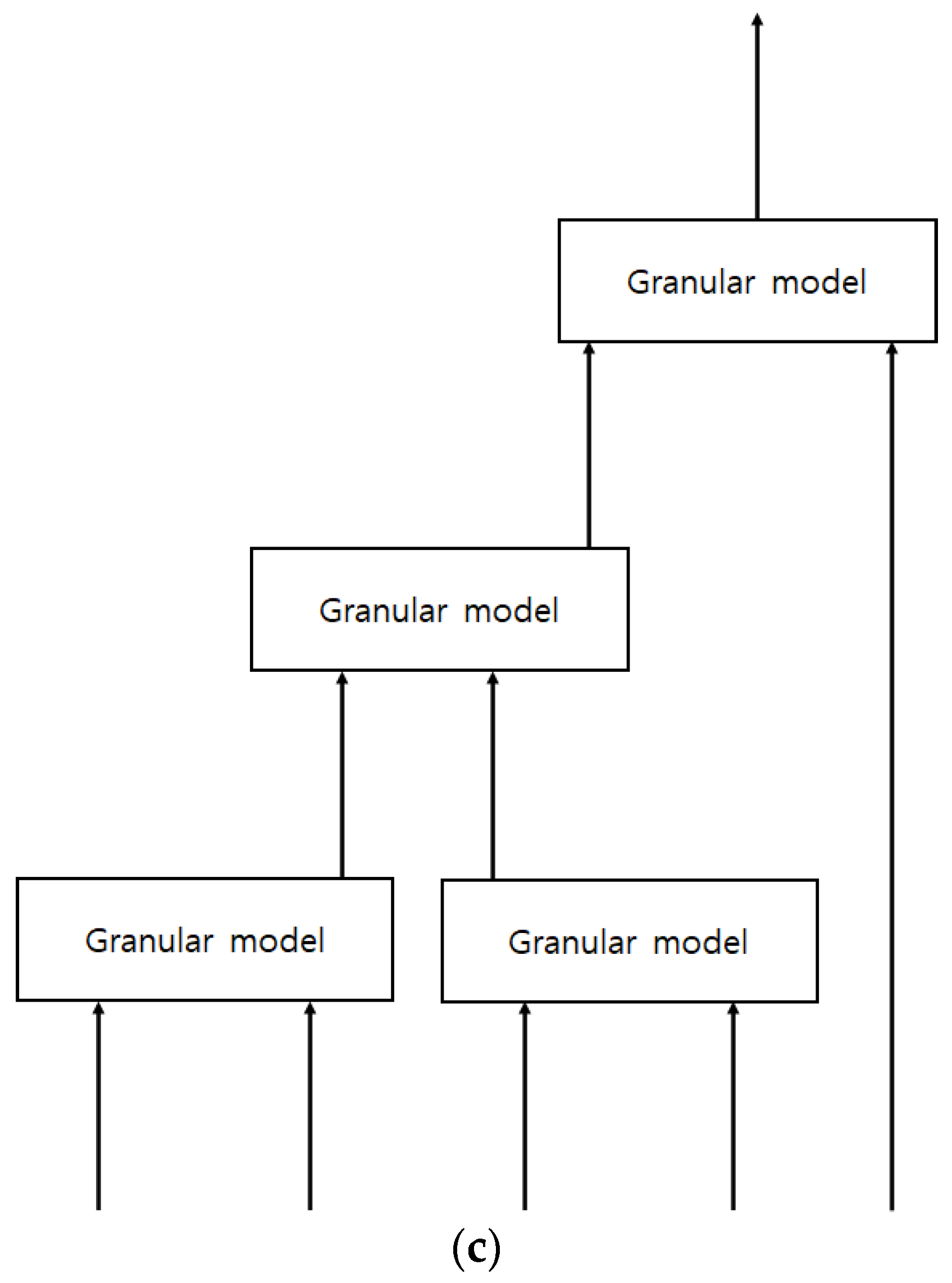

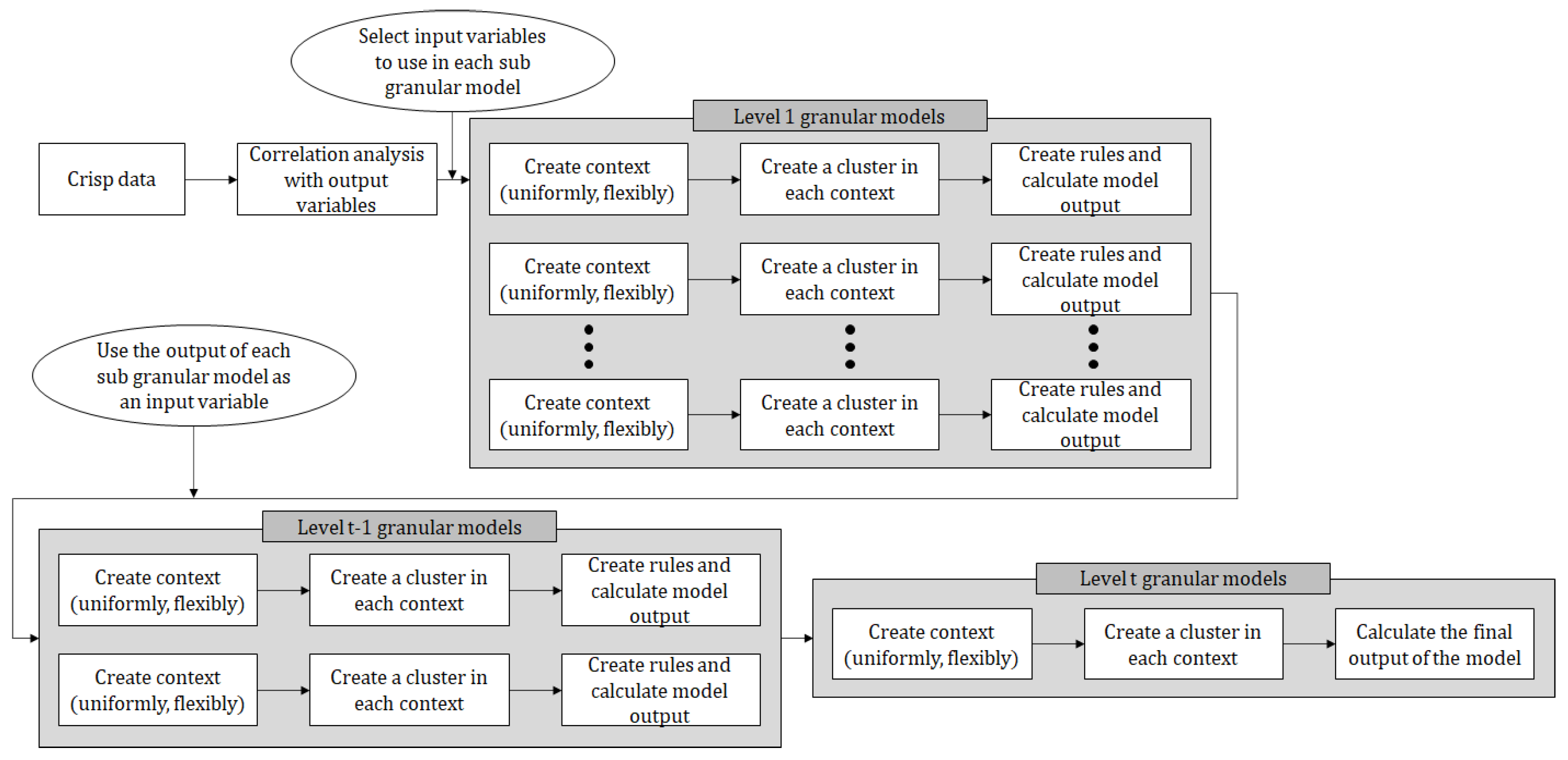
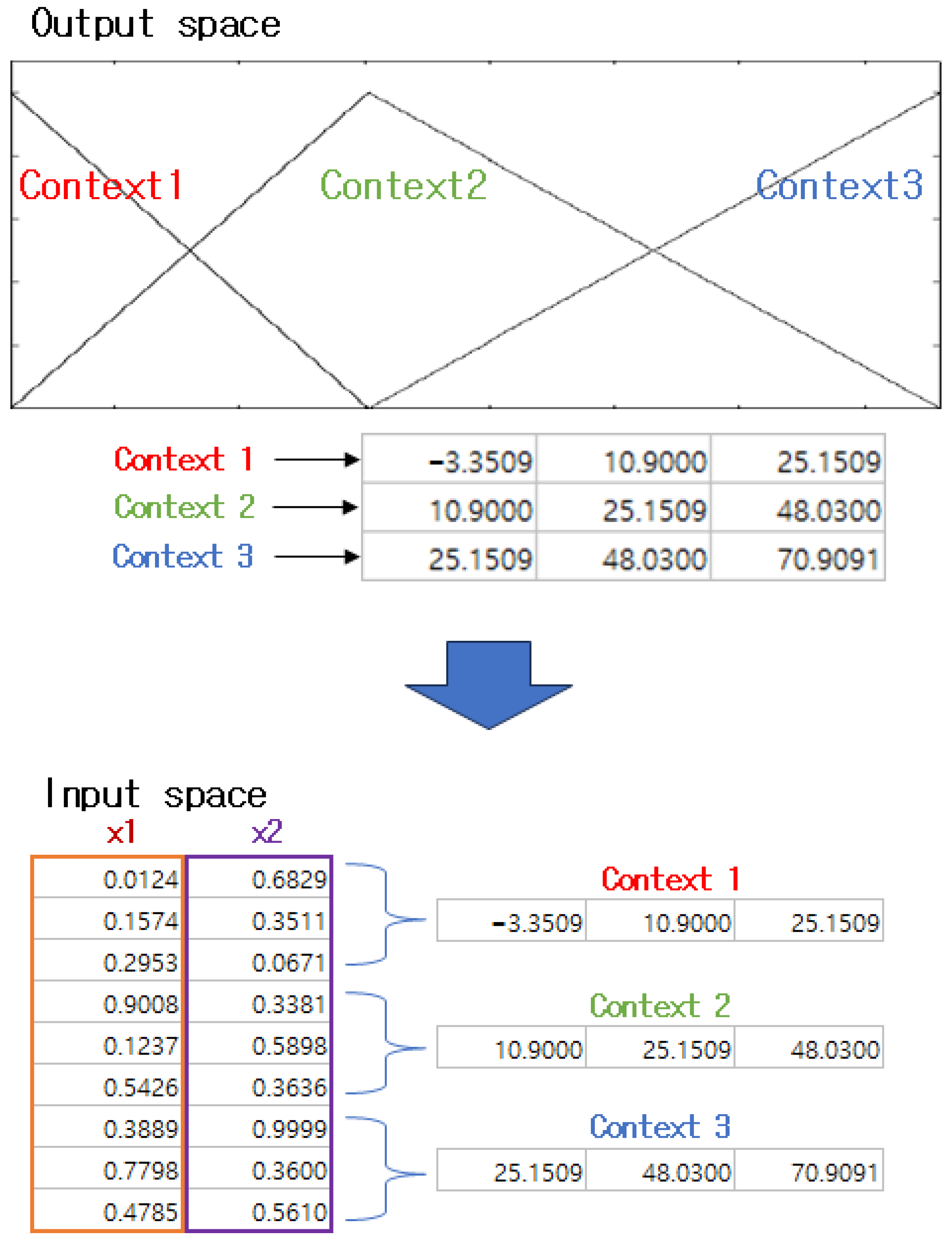
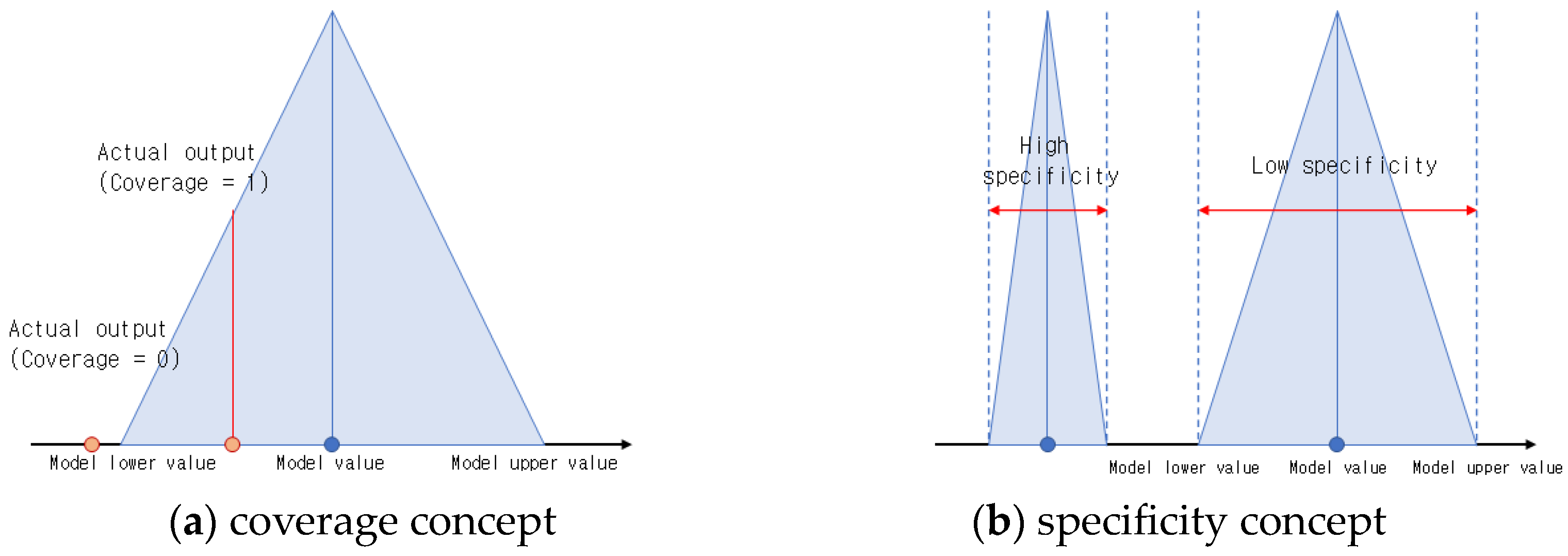
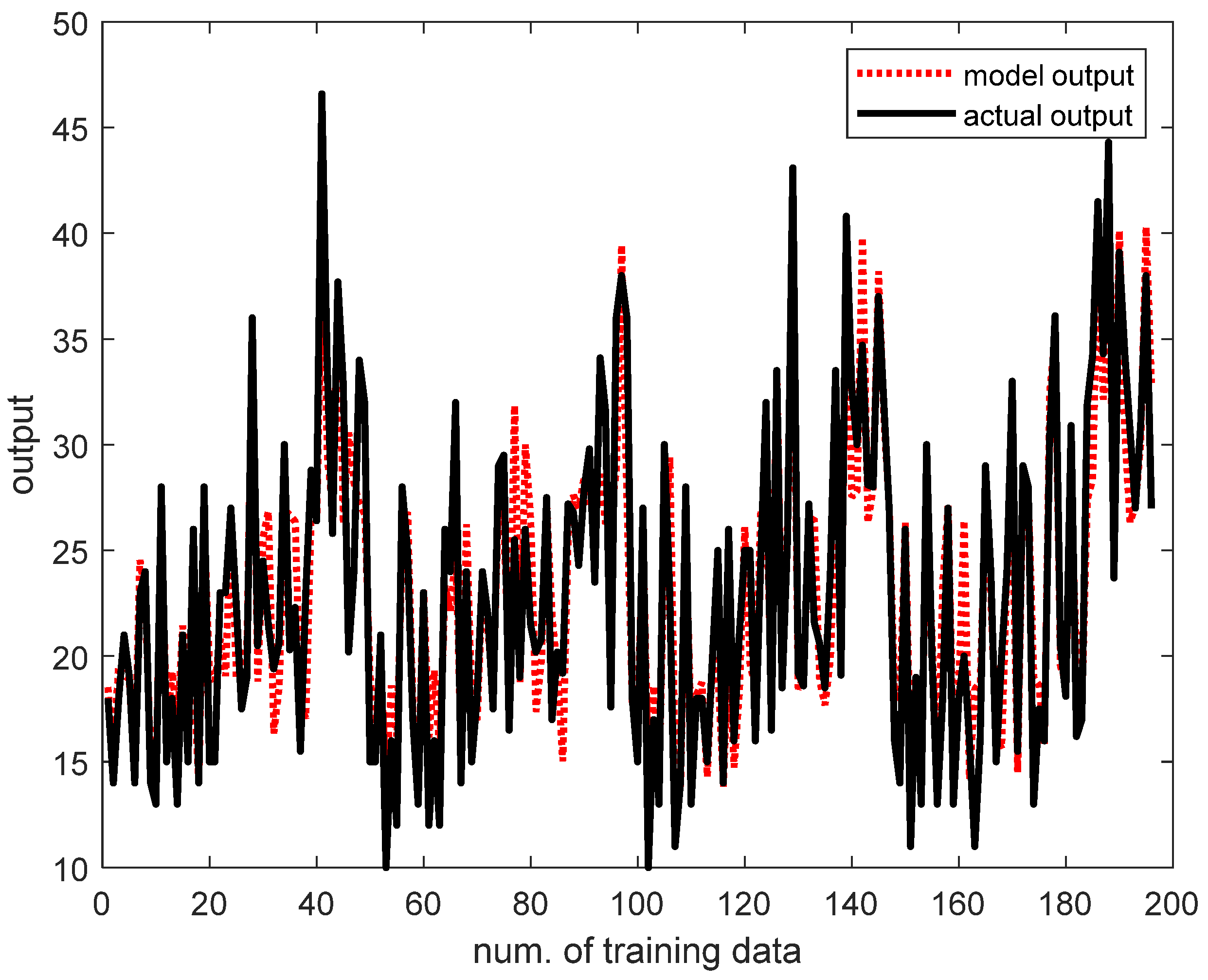
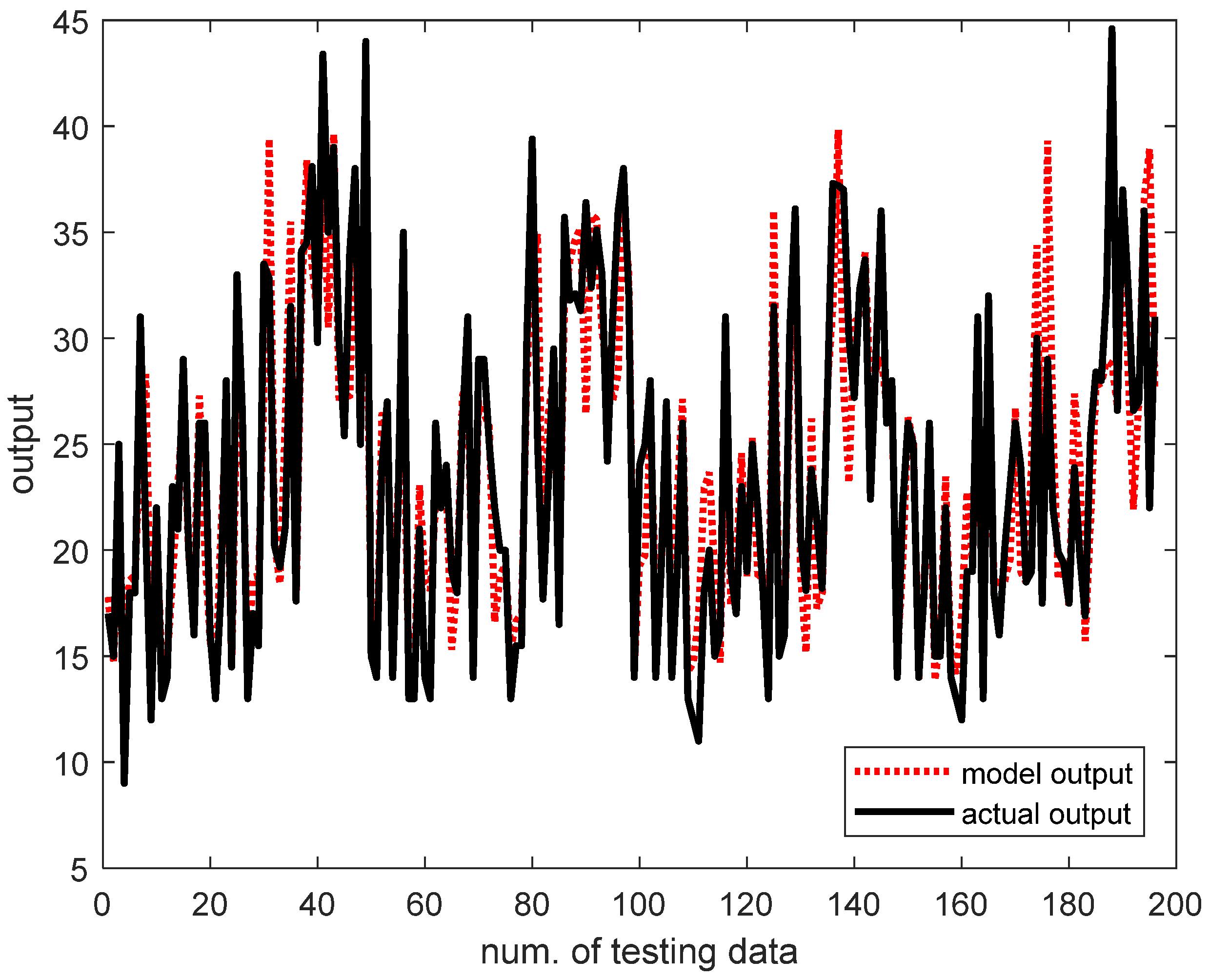
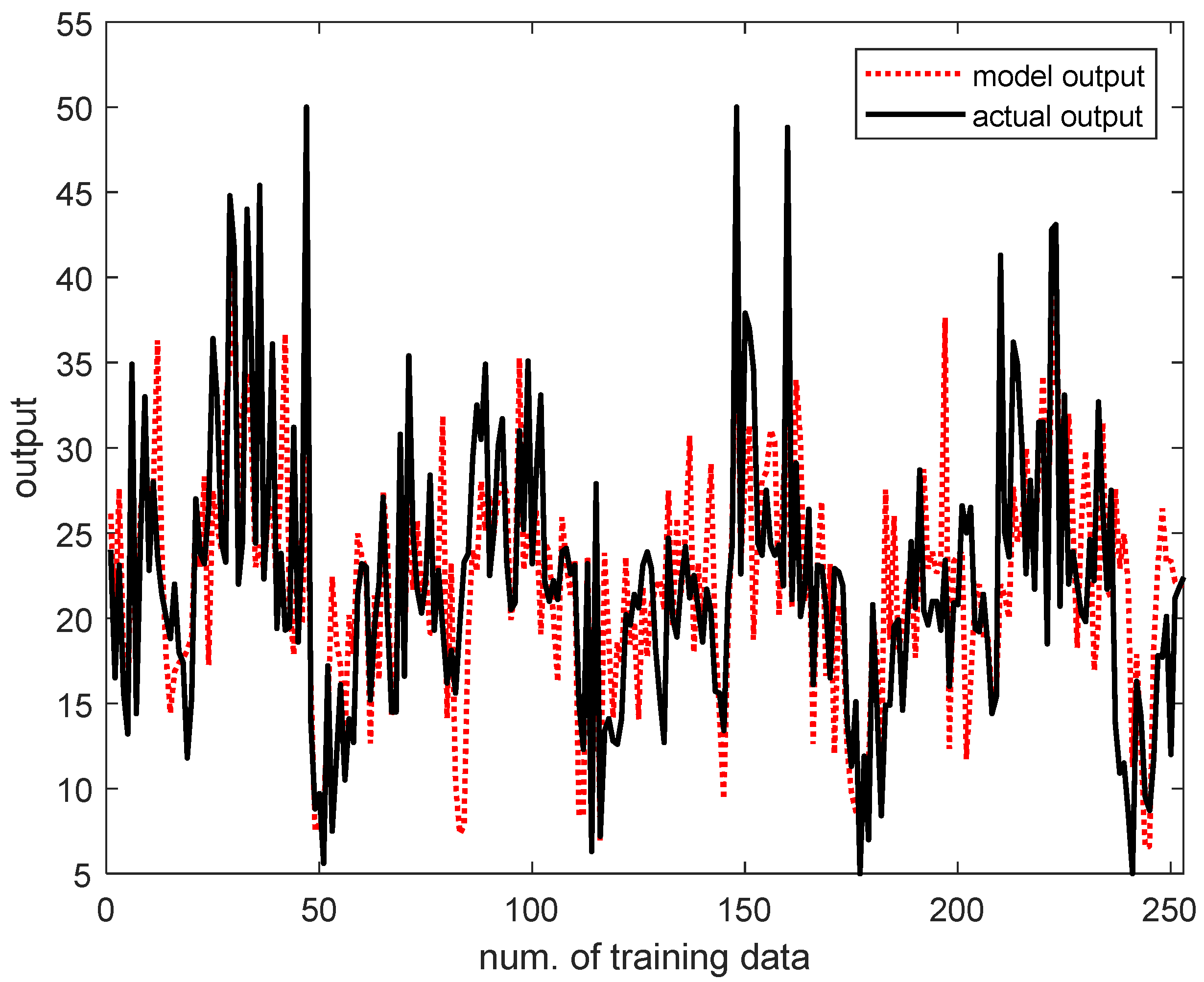


| m | Context | C | 2 | 3 | 4 | 5 | 6 | |
| P | ||||||||
| 1.5 | Uniform | 2 | 0 | 0 | 0 | 0 | 0 | |
| 3 | 0.2687 | 0.2701 | 0.2855 | 0.3002 | 0.2826 | |||
| 4 | 0.3647 | 0.3690 | 0.3838 | 0.3790 | 0.3431 | |||
| 5 | 0.4600 | 0.4101 | 0.4177 | 0.4143 | 0.3932 | |||
| 6 | 0.4526 | 0.4651 | 0.4304 | 0.3800 | 0.4182 | |||
| Context | C | 2 | 3 | 4 | 5 | 6 | ||
| P | ||||||||
| Flexible | 2 | 0 | 0 | 0 | 0 | 0 | ||
| 3 | 0.2871 | 0.2597 | 0.2246 | 0.2805 | 0.3187 | |||
| 4 | 0.3893 | 0.3701 | 0.3843 | 0.3690 | 0.3533 | |||
| 5 | 0.4105 | 0.3902 | 0.4050 | 0.4099 | 0.3793 | |||
| 6 | 0.4346 | 0.4419 | 0.3970 | 0.3890 | 0.3915 | |||
| m | Context | C | 2 | 3 | 4 | 5 | 6 | |
| P | ||||||||
| 2 | Uniform | 2 | 0 | 0 | 0 | 0 | 0 | |
| 3 | 0.3027 | 0.2907 | 0.2945 | 0.3069 | 0.3115 | |||
| 4 | 0.4294 | 0.4017 | 0.4014 | 0.3759 | 0.3828 | |||
| 5 | 0.4278 | 0.4028 | 0.4481 | 0.4036 | 0.4165 | |||
| 6 | 0.4091 | 0.4445 | 0.4447 | 0.4213 | 0.4619 | |||
| Context | C | 2 | 3 | 4 | 5 | 6 | ||
| P | ||||||||
| Flexible | 2 | 0 | 0 | 0 | 0 | 0 | ||
| 3 | 0.3248 | 0.3184 | 0.2914 | 0.3055 | 0.3004 | |||
| 4 | 0.4494 | 0.4301 | 0.4605 | 0.4197 | 0.4520 | |||
| 5 | 0.4771 | 0.4160 | 0.4203 | 0.4689 | 0.4453 | |||
| 6 | 0.4219 | 0.4416 | 0.4311 | 0.4534 | 0.4258 | |||
| m | Context | C | 2 | 3 | 4 | 5 | 6 | |
| P | ||||||||
| 1.5 | Uniform | 2 | 0 | 0 | 0 | 0 | 0 | |
| 3 | 0.2493 | 0.2766 | 0.2808 | 0.2966 | 0.2747 | |||
| 4 | 0.3915 | 0.3568 | 0.3854 | 0.3833 | 0.3573 | |||
| 5 | 0.4505 | 0.3713 | 0.3921 | 0.4036 | 0.4398 | |||
| 6 | 0.4538 | 0.4602 | 0.4559 | 0.4060 | 0.4247 | |||
| Context | C | 2 | 3 | 4 | 5 | 6 | ||
| P | ||||||||
| Flexible | 2 | 0 | 0 | 0 | 0 | 0 | ||
| 3 | 0.2696 | 0.2620 | 0.2132 | 0.2714 | 0.3021 | |||
| 4 | 0.3860 | 0.3593 | 0.3432 | 0.3509 | 0.3809 | |||
| 5 | 0.4098 | 0.4505 | 0.4110 | 0.4170 | 0.3844 | |||
| 6 | 0.4055 | 0.4408 | 0.4080 | 0.4090 | 0.3865 | |||
| m | Context | C | 2 | 3 | 4 | 5 | 6 | |
| P | ||||||||
| 2 | Uniform | 2 | 0 | 0 | 0 | 0 | 0 | |
| 3 | 0.3001 | 0.2874 | 0.2909 | 0.2805 | 0.2962 | |||
| 4 | 0.4068 | 0.4149 | 0.3938 | 0.4254 | 0.4290 | |||
| 5 | 0.4641 | 0.4599 | 0.4435 | 0.4600 | 0.4513 | |||
| 6 | 0.4553 | 0.4737 | 0.4530 | 0.4479 | 0.4710 | |||
| Context | C | 2 | 3 | 4 | 5 | 6 | ||
| P | ||||||||
| Flexible | 2 | 0 | 0 | 0 | 0 | 0 | ||
| 3 | 0.2935 | 0.2837 | 0.3133 | 0.3320 | 0.2877 | |||
| 4 | 0.4395 | 0.4266 | 0.4178 | 0.4270 | 0.4334 | |||
| 5 | 0.4458 | 0.4610 | 0.4351 | 0.4850 | 0.4734 | |||
| 6 | 0.4597 | 0.4909 | 0.4798 | 0.4864 | 0.4724 | |||
| m | Context | C | 2 | 3 | 4 | 5 | 6 | |
| P | ||||||||
| 1.5 | Uniform | 2 | 0 | 0 | 0 | 0 | 0 | |
| 3 | 0.2679 | 0.2735 | 0.2797 | 0.2616 | 0.2577 | |||
| 4 | 0.3767 | 0.3430 | 0.3439 | 0.3382 | 0.3763 | |||
| 5 | 0.3823 | 0.3163 | 0.3502 | 0.3501 | 0.3392 | |||
| 6 | 0.4212 | 0.4330 | 0.4835 | 0.4001 | 0.3689 | |||
| Context | C | 2 | 3 | 4 | 5 | 6 | ||
| P | ||||||||
| Flexible | 2 | 0 | 0 | 0 | 0 | 0 | ||
| 3 | 0.2920 | 0.2473 | 0.2734 | 0.2831 | 0.2607 | |||
| 4 | 0.3854 | 0.3441 | 0.3670 | 0.3759 | 0.3284 | |||
| 5 | 0.3646 | 0.3487 | 0.3548 | 0.3914 | 0.3714 | |||
| 6 | 0.3517 | 0.3646 | 0.3558 | 0.4101 | 0.3671 | |||
| m | Context | C | 2 | 3 | 4 | 5 | 6 | |
| P | ||||||||
| 2 | Uniform | 2 | 0 | 0 | 0 | 0 | 0 | |
| 3 | 0.2723 | 0.2745 | 0.2793 | 0.2834 | 0.2897 | |||
| 4 | 0.3823 | 0.3520 | 0.3711 | 0.3909 | 0.3778 | |||
| 5 | 0.3387 | 0.3305 | 0.3478 | 0.3670 | 0.3605 | |||
| 6 | 0.4158 | 0.3834 | 0.4181 | 0.4238 | 0.4370 | |||
| Context | C | 2 | 3 | 4 | 5 | 6 | ||
| P | ||||||||
| Flexible | 2 | 0 | 0 | 0 | 0 | 0 | ||
| 3 | 0.3031 | 0.3014 | 0.2885 | 0.2898 | 0.2949 | |||
| 4 | 0.3839 | 0.3653 | 0.3601 | 0.3878 | 0.3894 | |||
| 5 | 0.3518 | 0.3717 | 0.3843 | 0.3775 | 0.3998 | |||
| 6 | 0.3828 | 0.3627 | 0.3798 | 0.4072 | 0.4045 | |||
| m | Context | C | 2 | 3 | 4 | 5 | 6 | |
| P | ||||||||
| 1.5 | Uniform | 2 | 0 | 0 | 0 | 0 | 0 | |
| 3 | 0.2481 | 0.2718 | 0.2646 | 0.2651 | 0.2549 | |||
| 4 | 0.3917 | 0.3881 | 0.3783 | 0.4073 | 0.4010 | |||
| 5 | 0.3862 | 0.3426 | 0.3659 | 0.3699 | 0.3676 | |||
| 6 | 0.4478 | 0.4412 | 0.4603 | 0.4233 | 0.3852 | |||
| Context | C | 2 | 3 | 4 | 5 | 6 | ||
| P | ||||||||
| Flexible | 2 | 0 | 0 | 0 | 0 | 0 | ||
| 3 | 0.2995 | 0.2966 | 0.2865 | 0.2663 | 0.2860 | |||
| 4 | 0.3765 | 0.3275 | 0.3391 | 0.3477 | 0.3425 | |||
| 5 | 0.3860 | 0.3396 | 0.3908 | 0.3997 | 0.3744 | |||
| 6 | 0.3698 | 0.4054 | 0.3892 | 0.3762 | 0.3348 | |||
| m | Context | C | 2 | 3 | 4 | 5 | 6 | |
| P | ||||||||
| 2 | Uniform | 2 | 0 | 0 | 0 | 0 | 0 | |
| 3 | 0.2836 | 0.2802 | 0.2890 | 0.2834 | 0.3195 | |||
| 4 | 0.3665 | 0.3729 | 0.3901 | 0.3969 | 0.3818 | |||
| 5 | 0.3668 | 0.3462 | 0.3414 | 0.3759 | 0.3304 | |||
| 6 | 0.3208 | 0.3850 | 0.4100 | 0.4161 | 0.4354 | |||
| Context | C | 2 | 3 | 4 | 5 | 6 | ||
| P | ||||||||
| Flexible | 2 | 0 | 0 | 0 | 0 | 0 | ||
| 3 | 0.3127 | 0.3237 | 0.3116 | 0.3096 | 0.3310 | |||
| 4 | 0.3921 | 0.3912 | 0.3942 | 0.3945 | 0.3951 | |||
| 5 | 0.3701 | 0.3498 | 0.3630 | 0.3647 | 0.4252 | |||
| 6 | 0.3663 | 0.3749 | 0.3468 | 0.3475 | 0.3679 | |||
| Databases | Models | m | Context | P | C | Rules | PI | Time (s) |
|---|---|---|---|---|---|---|---|---|
| Auto MPG | MGFM | 1.5 | Uniform | 6 | 3 | 18 | 0.4602 | 0.0133 |
| Flexible | 5 | 3 | 15 | 0.4505 | 0.0132 | |||
| 2 | Uniform | 6 | 3 | 18 | 0.4737 | 0.0127 | ||
| Flexible | 6 | 3 | 18 | 0.4909 | 0.0104 | |||
| GFM | 2 | Uniform | 6 | 3 | 18 | 0.3986 | 0.0400 | |
| Boston housing | MGFM | 1.5 | Uniform | 6 | 4 | 24 | 0.4603 | 1.2834 |
| Flexible | 6 | 3 | 18 | 0.4053 | 1.2634 | |||
| 2 | Uniform | 6 | 6 | 36 | 0.4353 | 1.3044 | ||
| Flexible | 5 | 6 | 30 | 0.4253 | 1.2937 | |||
| GFM | 2 | Uniform | 5 | 6 | 30 | 0.3043 | 1.3427 | |
| Energy efficiency | MGFM | 1.5 | Uniform | 5 | 6 | 30 | 0.4585 | 0.5562 |
| Flexible | 5 | 5 | 25 | 0.4774 | 0.5472 | |||
| 2 | Uniform | 5 | 4 | 20 | 0.4824 | 0.2561 | ||
| Flexible | 6 | 4 | 24 | 0.4952 | 0.2834 | |||
| GFM | 2 | Uniform | 4 | 3 | 12 | 0.4561 | 1.9887 |
Disclaimer/Publisher’s Note: The statements, opinions and data contained in all publications are solely those of the individual author(s) and contributor(s) and not of MDPI and/or the editor(s). MDPI and/or the editor(s) disclaim responsibility for any injury to people or property resulting from any ideas, methods, instructions or products referred to in the content. |
© 2023 by the authors. Licensee MDPI, Basel, Switzerland. This article is an open access article distributed under the terms and conditions of the Creative Commons Attribution (CC BY) license (https://creativecommons.org/licenses/by/4.0/).
Share and Cite
Yeom, C.-U.; Kwak, K.-C. A Design and Its Application of Multi-Granular Fuzzy Model with Hierarchical Tree Structures. Appl. Sci. 2023, 13, 11175. https://doi.org/10.3390/app132011175
Yeom C-U, Kwak K-C. A Design and Its Application of Multi-Granular Fuzzy Model with Hierarchical Tree Structures. Applied Sciences. 2023; 13(20):11175. https://doi.org/10.3390/app132011175
Chicago/Turabian StyleYeom, Chan-Uk, and Keun-Chang Kwak. 2023. "A Design and Its Application of Multi-Granular Fuzzy Model with Hierarchical Tree Structures" Applied Sciences 13, no. 20: 11175. https://doi.org/10.3390/app132011175
APA StyleYeom, C.-U., & Kwak, K.-C. (2023). A Design and Its Application of Multi-Granular Fuzzy Model with Hierarchical Tree Structures. Applied Sciences, 13(20), 11175. https://doi.org/10.3390/app132011175







